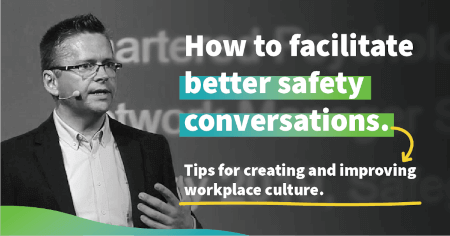Even after two decades in the industry, Steven Shorrock is still surprised that accidents don’t happen more often. “That’s what you would expect when you actually look at some of the complexities of work,” Steven says.
Steven Shorrock, Senior Specialist Safety Human Factors for EUROCONTROL UK is an expert in work, having spent the last 20 years enabling better conversations about real work with frontline team members and management.
“When we look at the worst aspects of safety, where things go wrong, what we’re really learning from them is unsafety,” he says.
Get fresh H&S insights weekly
Shifting the perspective of safety
‘Safety-II thinking' emphasises the difference between the concepts of work-as-imagined and work-as-done. A different approach, known as ‘Human Factors’, suggests there are four kinds of work: work-as-imagined, work-as-done, work-as-prescribed and work-as-disclosed.
Why does this matter? Because understanding the differences between these will help you better understand work – and how it can be made better and safer.
If organisations are to significantly impact their workplace safety culture, they need to have better conversations about real work. To do that, they must understand the work before they can make it better and safer.
Here are the key takeaways from Steven’s international keynote speech at last year’s Safeguard National Health and Safety Conference.
The human factors explained
-
Work-as-imagined
This is the work based on assumptions: it’s how we think other people work, how they think we work and also what we imagine will happen to the work after we introduce changes.
The challenge with work-as-imagined is, even though it’s a simplified form of work, there are infinite scenarios – and all of them are fundamentally incorrect, in many ways.
-
Work-as-done
As the name suggests, it’s the work that people really do, and it’s a constant battle of variables and adjustments. Take a taxi driver, for example, who constantly adjusts his or her steering, brakes and acceleration – actions that are necessary to get the job done.
But there’s always a trade-off, Steven explains. You can’t be efficient and thorough. You can’t focus on the here and now at the same time as the forward-planning.
-
Work-as-prescribed
This is the work governed by policy and procedure, regulations, laws and guidelines. Although organisations can have lots of these, there can only be one for each job or task. They don’t often change over time, and because it’s easy to keep adding them, procedure can quickly disrupt the flow of work.
-
Work-as-disclosed
This describes the information that we disclose to other people about our work – and often, we don’t share the whole truth for various reasons. What we say is motivated by who is asking the questions and what the consequences will be.
Archetypes of work
When we look at the four varieties of work together, it’s evident that there are areas that overlap. Understanding how the concepts interact will help organisations generate better conversations about work, Steven says.
-
The messy reality: work-as-done but not-as-prescribed. It’s the work that we do that doesn’t have a procedure. For many organisations, this is most of the work.
-
Congruence: work-as-done, work-as-prescribed and work-as-imagined. You’re working strictly within the defined rules, but it’s not what people imagine to be the work.
-
Taboo: work-as-done but not-as-disclosed. Work activities that people don’t want to talk about because others may find them unacceptable.
-
Ignorance and fantasy: work-as-imagined and as-prescribed but not work-as-done. What people imagine happens based on policy and procedure.
-
Projection: work-as-imagined, often as-prescribed and perhaps as-disclosed. It’s how we imagine work will be in the future, most commonly the case when a new system is implemented based on its perceived use.
-
PR and subterfuge: work-as-disclosed and often as-prescribed, but not as-done. This is what people say happens even though it does not reflect the reality. What is disclosed will often relate to what ‘should’ happen according to policies and procedures.
-
Defunct: work-as-prescribed but not as-done. When prescribed work is not done but is still officially in place, some will imagine that it’s in place, while others know or think it isn’t.
Practical tips for having better work conversations
For Steven, the answer to driving meaningful change in health and safety starts with conversations about real work. Unless organisations spend time talking to the people who do the work, assumptions can’t be made or imagined about improvements to work – and therefore workplace culture.
Here’s how you can enable better conversations about work in your organisation:
Understand the work as it is now: Create a safe environment and then ask people to share insights about their work. Focus on the work, not the worker’s performance.
Move away from compliance language: To have conversations about safety, organisations need to move away from red-tape language towards the vernacular of their workers.
Reassess your goals: People and systems have different goals and they’re often in tension or conflict with one another. Organisations want to improve safety, but also efficiency, productivity and capacity. Trying to meet too many goals at once will only cause inefficiency – and riskier safety decisions.
Don’t lead the conversation: In these conversations, health and safety practitioners are the apprentices – not the masters. The person who does the work focuses on explaining how it works, and those seeking to understand take on a listening and learning role.
Consider local rationality: People do things that make sense to them and are rational at the time given their demand, resources, capacity or capability.
Focus on interactions, strengths and assets: Don’t focus on individual actions or deficits. Instead, think glass-half-full, and pivot your focus to interactions between people, equipment and procedures. Ask your people if they feel safe in your organisation and why. Try and understand the different ways they interact with the business rather than the unsafe acts.
Make it easy for people to do the right thing
Traditionally, health and safety professionals would focus on what you don’t want to happen – accidents, incidents – rather than the safety outcomes you do want. The problem with this approach is, you have no visibility when normal day-to-day work changes – and becomes less or more unsafe.
To break this chain of focus, make work safer and significantly impact on workplace culture, organisations need to make it hard for people to do the wrong thing, and easy to do the right thing. Understanding work by enabling better conversations with people at the coalface will help drive these positive safety outcomes.
Want to know more about how ecoPortal health and safety software empowers businesses to keep people safe? Try a demo or get in touch with the team at ecoPortal.








